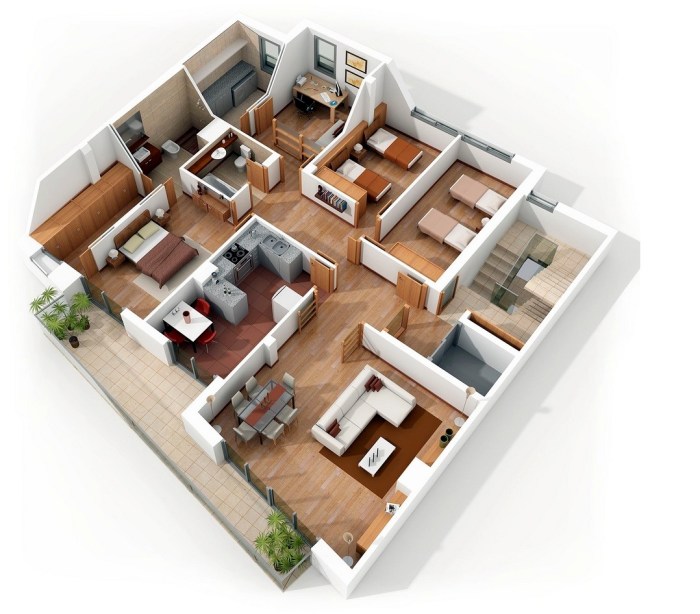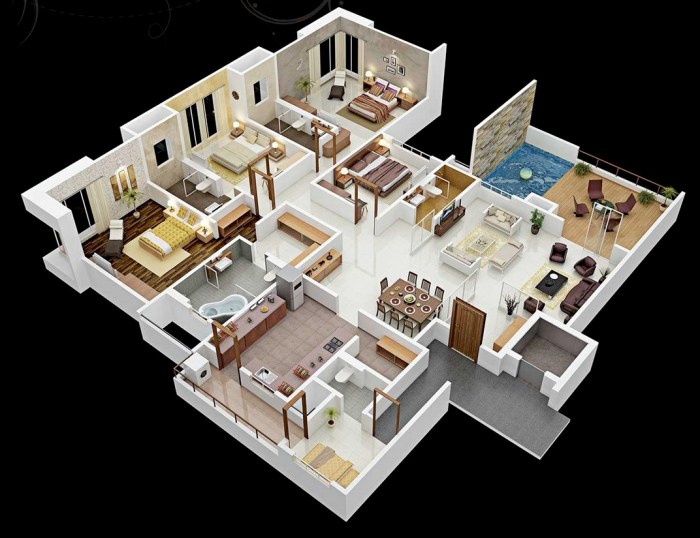Space Optimization and Functionality: 4 Bedroom Home Design

4 bedroom home design – Maximizing space and functionality in a four-bedroom home requires a strategic approach that blends clever design with practical solutions. Effective space planning ensures every area serves a purpose, contributing to a comfortable and efficient living environment. This involves careful consideration of storage solutions, furniture selection, and the strategic use of natural light to enhance the overall feeling of spaciousness.
Effective space optimization in a four-bedroom home involves a multifaceted approach, focusing on maximizing storage, utilizing multi-functional furniture, and strategically incorporating natural light to create a sense of spaciousness. Clever design choices can transform a potentially cramped space into a comfortable and functional living area.
Built-in Storage Solutions
Built-in storage is a game-changer for maximizing space in any home, especially one with multiple bedrooms. Custom-designed units seamlessly integrate into the architecture, eliminating the visual clutter of freestanding furniture. Examples include built-in wardrobes in bedrooms, maximizing vertical space and utilizing often-wasted areas like alcoves. In the kitchen, integrated pantry units and drawers can significantly increase storage capacity.
A built-in media unit in the living room can house electronics and accessories while maintaining a clean aesthetic. The key is to plan carefully, considering the specific needs of each room and the overall style of the house. Well-designed built-ins can significantly improve the home’s functionality and visual appeal.
Clever Closet Solutions
Beyond built-ins, innovative closet solutions are essential for optimizing storage in a four-bedroom home. Custom closet organizers, featuring adjustable shelves, drawers, and hanging rods, can significantly increase storage capacity. Vertical space is often underutilized; installing high shelves or using stackable storage containers can dramatically increase the usable area. Utilizing slimline hangers and vacuum-sealed storage bags can further maximize space efficiency.
For smaller closets, consider using over-the-door organizers or hanging shoe racks to keep items organized and easily accessible. These solutions not only increase storage but also enhance the overall organization and tidiness of the space.
Multi-functional Furniture, 4 bedroom home design
Multi-functional furniture is a key element in maximizing space in a four-bedroom home. A sofa bed in a guest room serves as both seating and a sleeping area, saving valuable floor space. Ottomans with built-in storage can provide extra seating while also concealing items such as blankets or games. A coffee table with drawers offers additional storage for remotes, magazines, or other items.
Folding tables and chairs are ideal for smaller dining areas or home offices, easily stored away when not in use. By strategically incorporating multi-functional furniture, one can significantly increase the functionality of each room without compromising on space.
Designing a four-bedroom home offers ample opportunity for diverse stylistic choices. For instance, one could consider a cohesive theme throughout, or opt for unique designs in each room. A particularly serene option for one bedroom might be incorporating a Japanese style, as seen in examples of japanese style bedroom design , which beautifully blends minimalism and tranquility.
This approach can then inform the overall aesthetic of the four-bedroom home design, creating a relaxing and harmonious atmosphere.
Creating a Sense of Spaciousness in Smaller 4-Bedroom Homes
Even in smaller homes, a sense of spaciousness can be achieved through careful planning and design choices. Light, neutral color palettes on walls and floors create a sense of openness and airiness. Mirrors strategically placed can reflect light and create the illusion of more space. Minimizing clutter is paramount; keep surfaces clear and organized. Large windows and skylights maximize natural light, brightening the space and enhancing the feeling of spaciousness.
Using furniture with thin legs creates a less visually bulky effect. Careful selection of furniture and decor can dramatically impact the perceived size of the home.
The Importance of Natural Light
Natural light plays a crucial role in creating a welcoming and spacious atmosphere. Maximizing natural light entry is vital. Large windows, strategically placed skylights, and glass doors allow ample sunlight to flood the interior, reducing the need for artificial lighting and creating a brighter, more inviting space. Consider using sheer curtains or blinds to control the amount of light entering the rooms, while still allowing natural light to diffuse throughout the house.
Light-colored walls and floors reflect light, further enhancing the brightness of the interior. Well-placed mirrors can also help to distribute natural light, making the space appear larger and more open. The impact of natural light on mood and well-being is significant, making it a crucial design element.
Sustainable Design Elements

Incorporating sustainable design features into a new home not only reduces its environmental footprint but also contributes to long-term cost savings for homeowners. This section will explore three key sustainable elements applicable to a four-bedroom home design, examining their environmental benefits and economic advantages.
Energy-Efficient Windows
Energy-efficient windows play a crucial role in minimizing energy consumption for heating and cooling. These windows typically feature multiple panes of glass separated by gas fills (like argon or krypton), low-emissivity (low-E) coatings, and improved frame materials. The multiple panes create an insulating barrier, reducing heat transfer between the interior and exterior of the home. The low-E coatings reflect infrared radiation, further minimizing heat loss in winter and heat gain in summer.
Improved frame materials, such as fiberglass or composite, offer superior insulation compared to traditional wood or vinyl frames. This results in lower energy bills and a reduced carbon footprint from decreased reliance on fossil fuel-based energy sources. For example, a home using high-performance windows could reduce heating and cooling costs by 20-30% compared to a home with standard windows, leading to substantial savings over the lifespan of the home.
Solar Panels
Solar photovoltaic (PV) panels convert sunlight directly into electricity, significantly reducing reliance on the power grid. The panels are installed on the roof and generate clean, renewable energy. The amount of energy produced depends on factors such as panel size, solar irradiance, and system efficiency. A well-designed solar panel system can significantly offset or even eliminate a home’s electricity bill, depending on energy consumption and sunlight availability.
The environmental benefit is considerable, reducing greenhouse gas emissions associated with electricity generation from fossil fuels. Moreover, some governments offer financial incentives such as tax credits or rebates to encourage solar panel adoption, further enhancing their cost-effectiveness. A family of four in a sunny climate could potentially reduce their electricity bill by 50% or more with a properly sized solar panel system, leading to substantial long-term savings.
Water-Saving Fixtures
Water-saving fixtures, including low-flow showerheads, toilets, and faucets, contribute to water conservation and reduced water bills. These fixtures use innovative technologies to reduce water consumption without sacrificing performance. Low-flow showerheads, for instance, use aerators to mix air with water, creating a satisfying shower experience while using significantly less water. Similarly, low-flow toilets employ efficient flushing mechanisms to minimize water usage per flush.
The environmental benefits include reduced strain on water resources and decreased energy consumption associated with water heating and treatment. The cost savings are immediate and ongoing, reflecting lower water and wastewater bills. A family of four could save hundreds of dollars annually on their water bills by installing water-efficient fixtures, a significant contribution to both their budget and water conservation efforts.
Cost Comparison of Sustainable Features
| Feature | Initial Cost (Estimate) | Annual Savings (Estimate) | Payback Period (Estimate) |
|---|---|---|---|
| Energy-Efficient Windows | $10,000 – $20,000 | $500 – $1500 | 6.7 – 40 years |
| Solar Panels (6kW system) | $15,000 – $30,000 | $1000 – $3000 | 5 – 30 years |
| Water-Saving Fixtures | $500 – $1500 | $100 – $300 | 1.7 – 5 years |
*Note: Cost and savings estimates are highly variable and depend on factors such as location, system size, energy prices, and water rates. These figures serve as illustrative examples only.*
FAQ Overview
What are the common challenges in designing a 4-bedroom home?
Common challenges include maximizing space efficiently, balancing individual needs within shared spaces, and managing the budget effectively while incorporating desired features.
How much does it typically cost to build a 4-bedroom home?
Building costs vary significantly based on location, materials, size, and finishes. It’s best to consult with local builders for accurate cost estimates.
What are some key considerations for a 4-bedroom home with a large family?
Key considerations include ample storage, multiple bathrooms, well-defined zones for different family members, and a flexible layout to accommodate changing needs.
